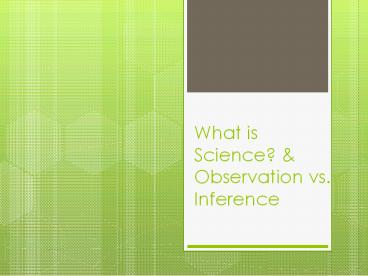What is Science? PowerPoint PPT Presentation
1 / 41
Title: What is Science?
1
What is Science? Observation vs. Inference
2
(No Transcript)
3
What is an observation?
- A. When you observe, you become aware of
something using one of your senses. Your five
senses are smell, taste, sight, touch, and sound.
In an observation you simply describe something
as it appears. An observation is a statement
describing a fact.
4
Observation
- In the space below, record 5 observations about
your science classroom. - 1.
- 2.
- 3.
- 4.
- 5.
5
Qualitative Observation
- B. A Qualitative observation is generally more
subjective, as it relies on the gathering of
information that is less easy to quantify,
Examples include studies of human behavior.
6
Quantitative Observation
- Quantitative research involves observations using
tools and methods that allow results to be
quantified in objective ways, usually using
numbers or measurements.Examples include
Microscopes, Telescopes, satellites, etc.
.
7
Next you are going to get into groups of two, you
will then decide who will be the observer and who
will be the interviewer. Once you have decided
you will turn your chairs to face your partner.
The observer will be the only person looking at
the smart board. You will each need paper and
pencil for this activity.
8
(No Transcript)
9
Next you will trade places and the interviewer
will ask a series of questions. You must write
the question.
10
Question 1
- Are there cars parked on the sides of the road?
11
Question 2
- What color is the pickup truck driving in the
road?
12
Question 3
- Are there any minivans around?
13
Question 4
- What was the sign on the utility pole?
14
Question 5
- What's the speed limit?
15
Question 6
- Are there any pedestrians on the road?
16
Question 7
- What color was the sign on the tree?
17
(No Transcript)
18
Answers
- Yes
- Yes
- Yes
- No Parking
- 35 mph
- No
- Blue/Green
19
We will now repeat the process and the
interviewer will now be the observer.
20
(No Transcript)
21
Questions
- Now you will switch again. The interviewer must
write the question.
22
Question 1
- How many cars were in the intersection?
23
Question 2
- Across the street, are there any parked cars on
the side?
24
Question 3
- Can you describe at least one of the cars driving
through the intersection?
25
Question 4
- Are there any potential witnesses?
26
Question 5
- What was this witness doing? Where was he?
27
Question 6
- What was the speed limit?
28
Question 7
- Was there anyone parked in the first parking
spot?
29
Questions Asked
- How many cars were in the intersection?Answer 2
- Across the street, are there any parked cars on
the side?Yes - Can you describe at least one of the cars driving
through the intersection? - Are there any other potential witnesses?If they
answer yes, ask the following question What was
this witness doing? Where was he?They should
have noticed a person mowing a lawn across the
street. - What was the speed limit?35
- Was there anyone parked in the first parking
spot?No
30
What is an inference?
- When you infer, you make a mental judgment based
on observations. Inferences cannot be directly
observed. They require thought. - For example, if you get up in the morning, look
up at the sky and observe dark clouds, observe
the air is cool and humid, and observe puddles on
the ground, you might infer that it has recently
rained. Note you did not see rain you decided
that it rained based on your observations. An
inference is a statement based on your
interpretation of the facts.
31
List 3 inferences about the classroom
- 1.
- 2.
- 3.
32
Examples
- Observations
- That plant is extremely wilted.
- The car stopped running
- Inferences
- That plant is extremely wilted due to a lack of
water. - The car stooped running because it was out of gas.
33
More examples
- What observations can we make about this picture?
- What can we infer based on this picture?
34
What observations can we make from these pictures?
35
Making Observations
- On the next several slides make observations
about the pictures you see.
36
(No Transcript)
37
(No Transcript)
38
(No Transcript)
39
(No Transcript)
40
Observation vs. Inference
- On the next slide, state whether the statement is
an observation or an inference.
41
- There is a representation of a face on one side
of the coin. - 2. The Latin word "Dei" means "God."
- 3. The coin was made by deeply religious people.
- 4. The date 1722 is printed on one side of the
coin. - 5. The coin was made in 1722.
- 6. The face on the coin is a representation of
the nation's president.

